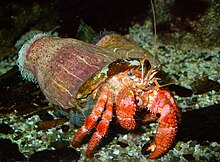This is an old revision of this page, as edited by JGGBorst (talk | contribs) at 12:07, 23 October 2014 (Corrected mode of action. Minor textual edits.). The present address (URL) is a permanent link to this revision, which may differ significantly from the current revision.
Revision as of 12:07, 23 October 2014 by JGGBorst (talk | contribs) (Corrected mode of action. Minor textual edits.)(diff) ← Previous revision | Latest revision (diff) | Newer revision → (diff)| Identifiers | |
|---|---|
| CAS Number | |
| Abbreviations | CLX |
| CompTox Dashboard (EPA) | |
| Properties | |
| Chemical formula | C203H305N55O72S7 |
| Molar mass | 4892.41 g·mol |
| Except where otherwise noted, data are given for materials in their standard state (at 25 °C , 100 kPa). Infobox references | |
| Calitoxin | |||||||
|---|---|---|---|---|---|---|---|
| Identifiers | |||||||
| Organism | Calliactis parasitica | ||||||
| Symbol | CLX | ||||||
| UniProt | P14531 | ||||||
| |||||||
| Identifiers | |||||||||
|---|---|---|---|---|---|---|---|---|---|
| Symbol | ? | ||||||||
| Pfam | PF00706 | ||||||||
| InterPro | IPR000693 | ||||||||
| |||||||||
Calitoxin, also known as CLX, is a sea anemone toxin which increases neurotransmitter release at invertebrate neuromuscular junctions. Two different toxins, namely CLX-1 and CLX-2, can be distinguished. It targets crabs and octopuses, among other invertebrates.
Etymology
Calitoxin (CLX), derives its name from the sea anemone Calliactis parasitica.
Sources
Calitoxin is a highly potent neurotoxin, which can be found in the nematocysts, organelles in stinging cells, of the Calliactis parasitica. This sea anemone is a species from the Hormathiidae family and is present along the European coasts of the Atlantic Ocean and in the Mediterranean Sea.
Structure and chemistry
The formula for calitoxin is C203H305N55O72S7. The amino acid sequence is markedly dissimilar from other known sea anemones toxins. Two genes coding for two highly homologous calitoxins are discovered and analyzed, namely CLX-1 and CLX-2, both consisting of 46 amino acids and originating from a precursor peptide of 79 amino acids where the C-terminus determines whether it will be the mature CLX-1 or CLX-2. In the mature CLX, one base-pair substitution is responsible for a single Glu to Lys replacement in the coding region of CLX-2, leading to the difference between the two peptides. The structural organization of these two genes show a high degree of homology. This might imply that the two different peptides have the same biological function. This cannot yet be confirmed because only CLX-1 has been isolated from C. parasitica.
Target and mode of action
Calitoxin causes massive neurotransmitter release from the nerve terminals of the neuromuscular junction, which in turn causes a strong muscle contraction and even paralysis. The exact target of calitoxin has not yet been clarified; because it has a similar action on the neuromuscular junction as Anemonia sulcata toxins, Calitoxin has been proposed to slow down the inactivation of voltage-gated sodium channels in motor neurons.
Function in nature

Sea anemones produce toxins, such as calitoxin, in their stinging cells (cnidocytes). These cells contain organelles called nematocysts. When triggered, an envenomation response occurs. This can result in injury to target organisms, including capture of prey, defense against predatory organisms, or against aggressors from within their own species. In a natural setting, C. parasitica establishes a mutualistic relationship with the hermit crab Pagurus bernhardus. The sea anemone identifies shells inhabited by the hermit crab and attaches. Through stings against potential predators, C. parasitica provides protection for the hermit crab. In return, the sea anemone gains an advantage in accessing a broader distribution of food sources, as the crab moves across the ocean floor. Octopuses will avoid shells bearing C. parasitica.
Toxicity
Calitoxin has been tested for activity on the crab Carcinus mediterraneus, by injecting a 0.1 mL solution with 0.2 µg lyophilized CLX of into the hemocoel. This revealed that the toxic unit corresponds to this minimum amount of the toxin inducing muscle contractions in the crab causing paralysis within 1 minute from injection. The LD50 is unknown.
References
- ^ Cariello, L; de Santis, A; Fiore, F; Piccoli, R; Spagnuolo, A; Zanetti, L; Parente, A (21 Mar 1989). "Calitoxin, a neurotoxic peptide from the sea anemone Calliactis parasitica: amino acid sequence and electrophysiological properties". Biochemistry. 28 (6): 2484–9. PMID 2567180.
{{cite journal}}:|access-date=requires|url=(help) - ^ Spagnuolo, Antonietta; Zanetti, Laura; Cariello, Lucio; Piccoli, Renata. "Isolation and characterization of two genes encoding calitoxins, neurotoxic peptides from Calliactis parasitica (Cnidaria)". Gene. 138 (1–2): 187–191. doi:10.1016/0378-1119(94)90805-2.
- Kastin, edited by Abba J. (2006). Handbook of biologically active peptides. Amsterdam: Academic Press. pp. 363–364. ISBN 0-12-369442-6.
{{cite book}}:|first1=has generic name (help) - John Fish & Susan Fish (2011). "Calliactis parasitica (Couch)". A Student's Guide to the Seashore (3rd ed.). Cambridge University Press. p. 96. ISBN 978-0-521-72059-5.
- Roger T. Hanlon & John B. Messenger (1998). "Learning and the development of behaviour". Cephalopod Behaviour. Cambridge University Press. pp. 132–148. ISBN 978-0-521-64583-6.